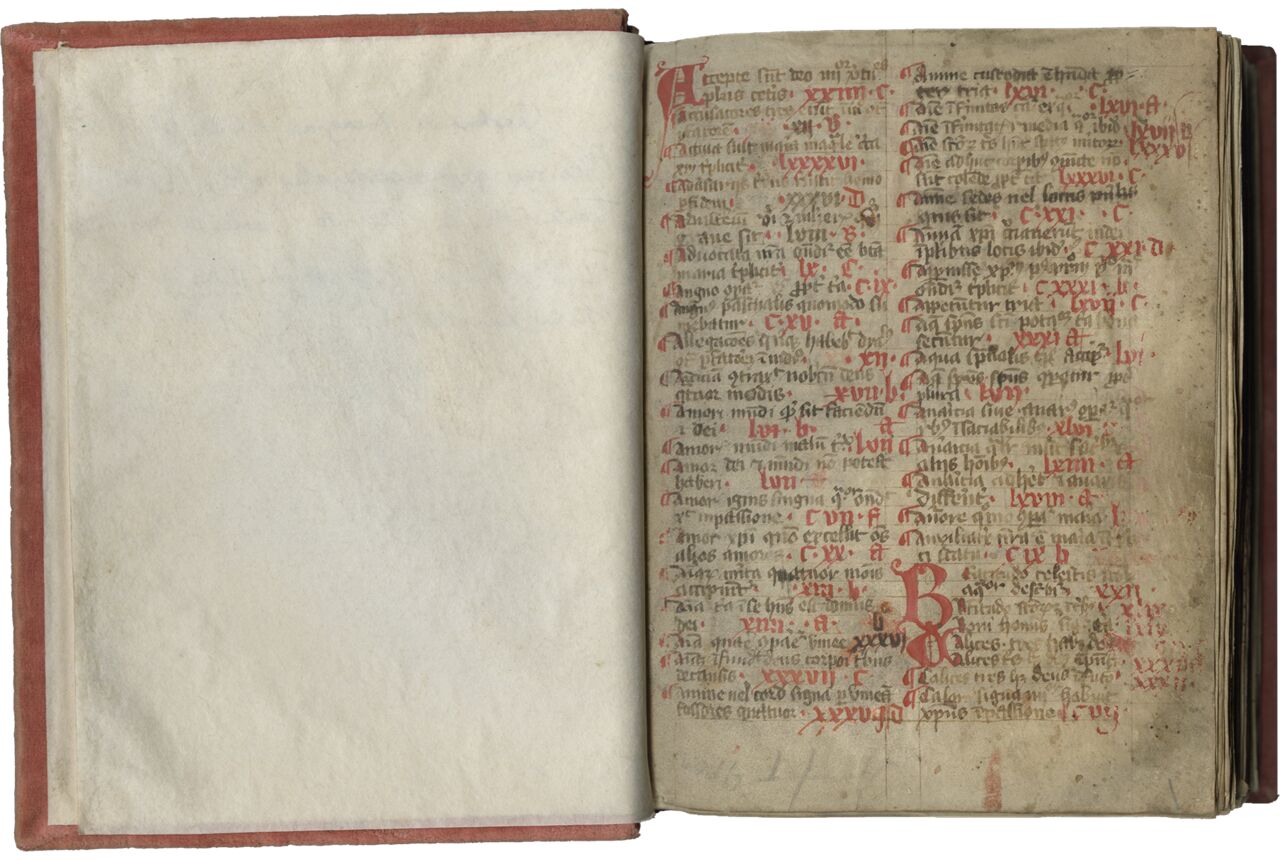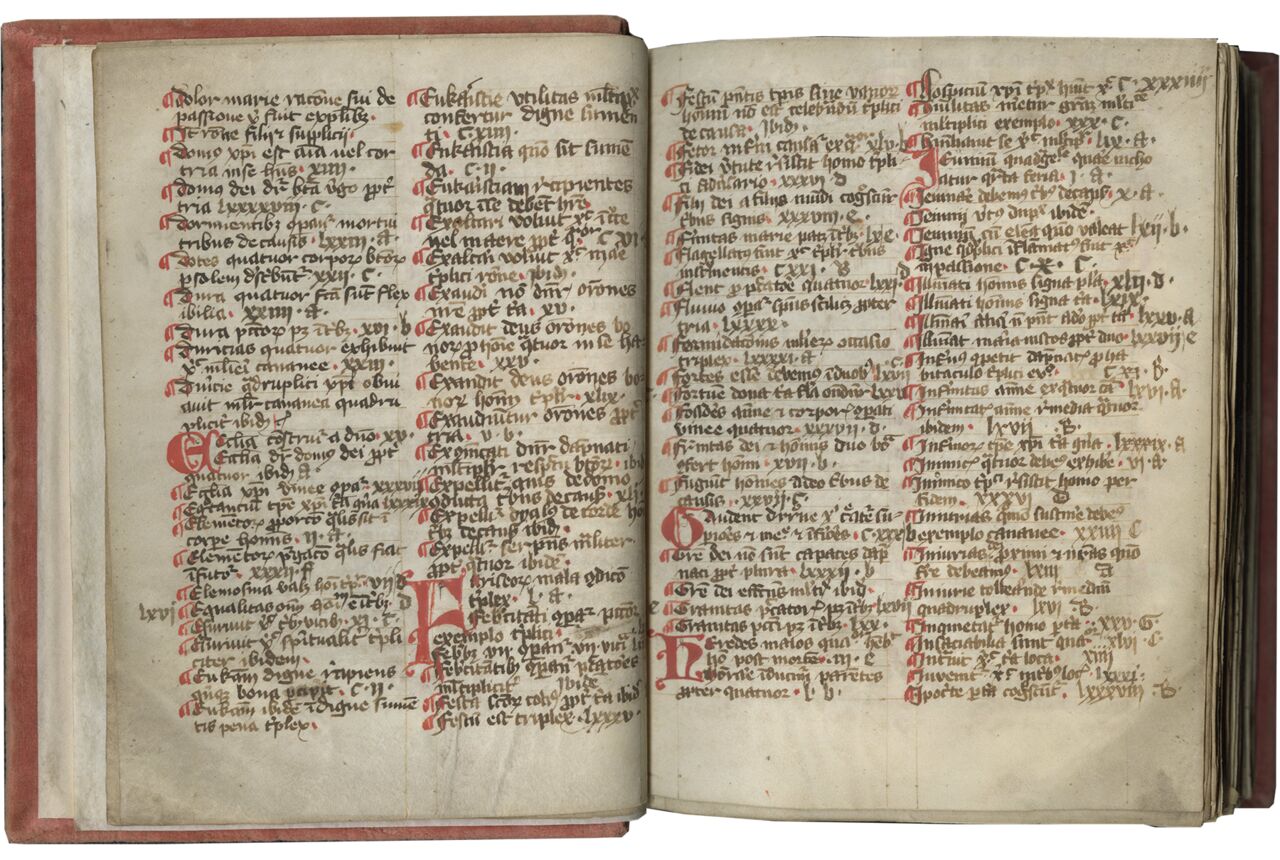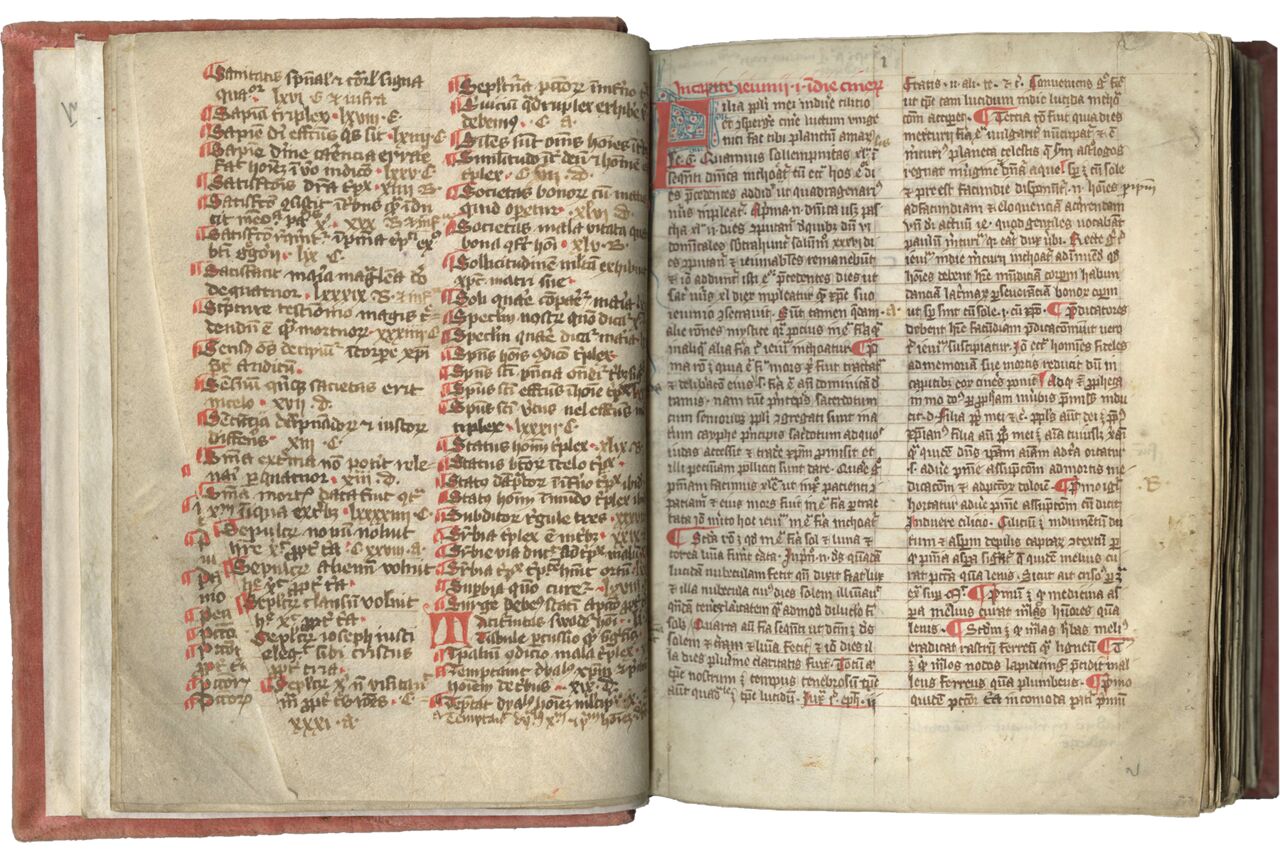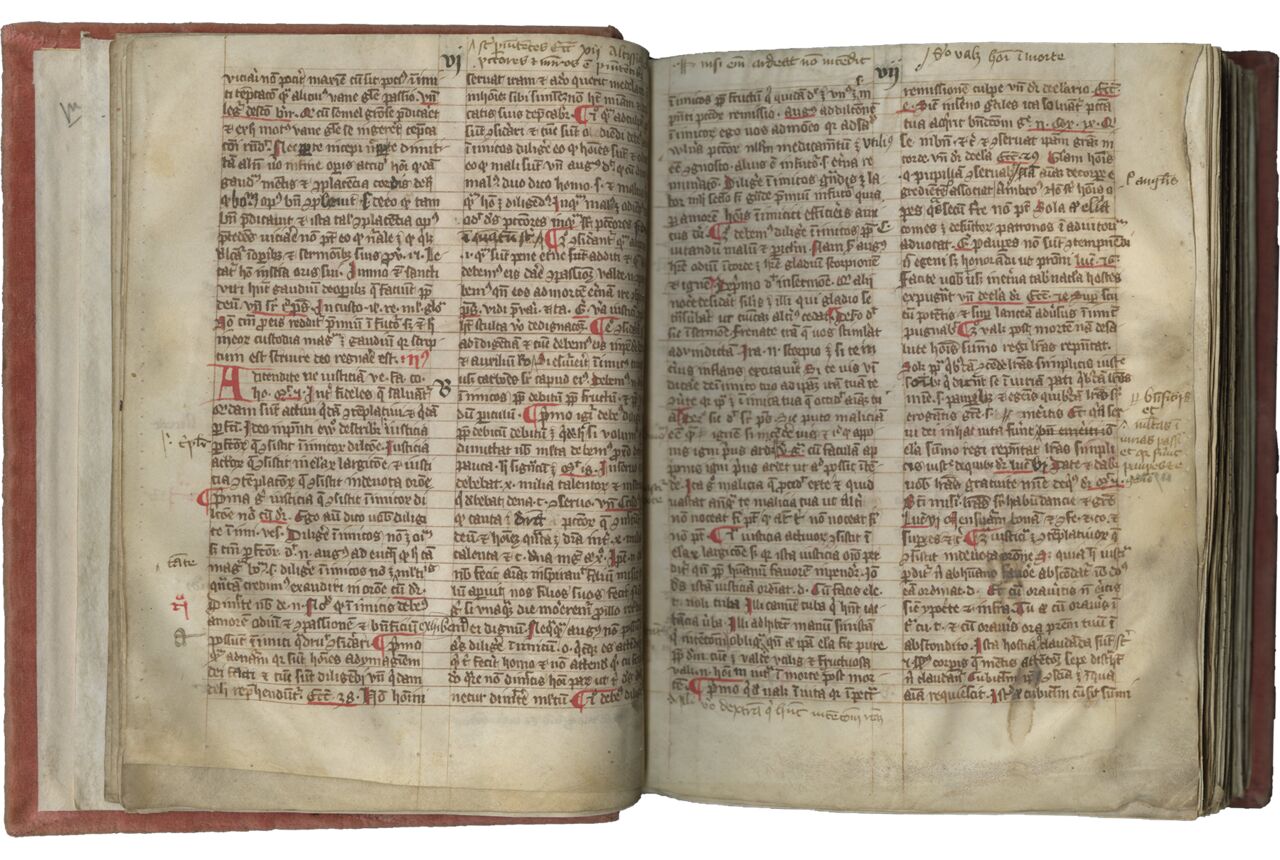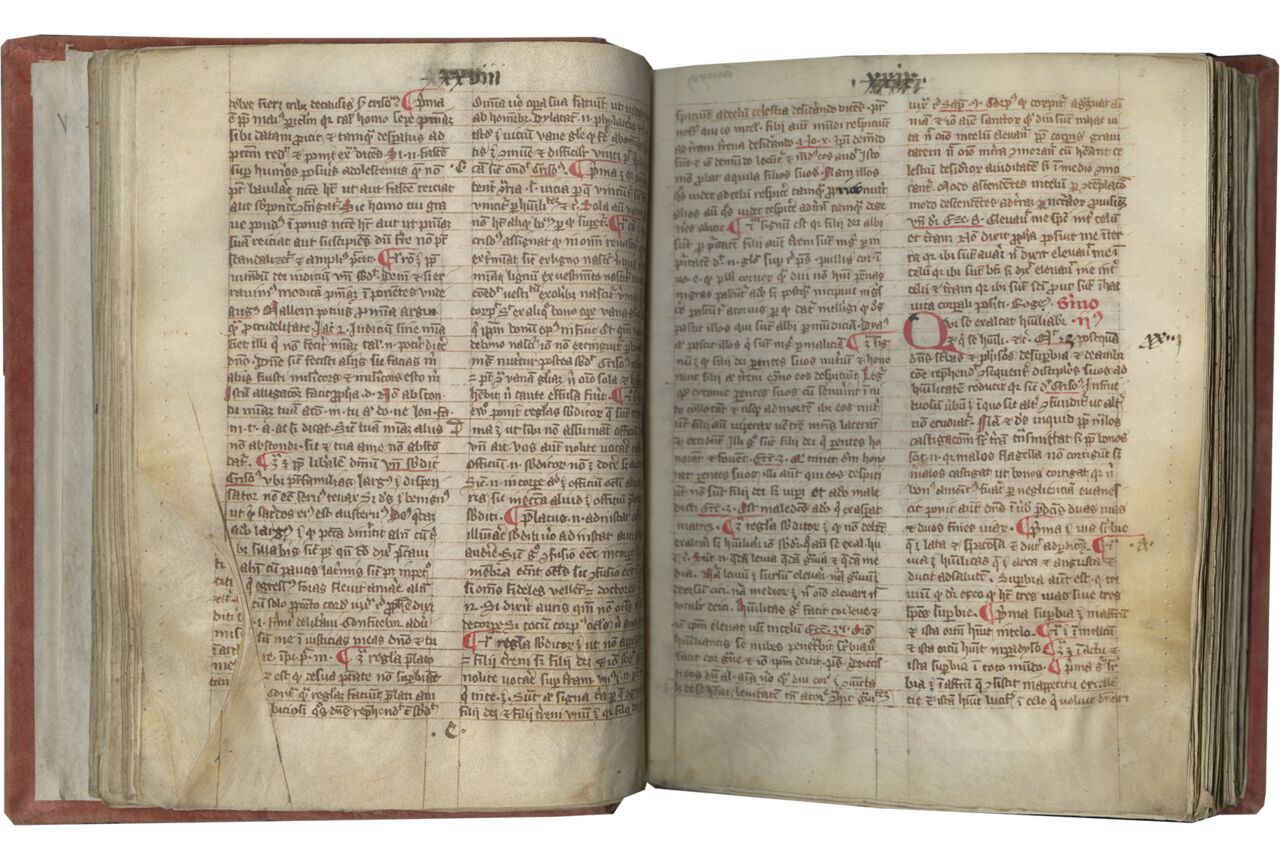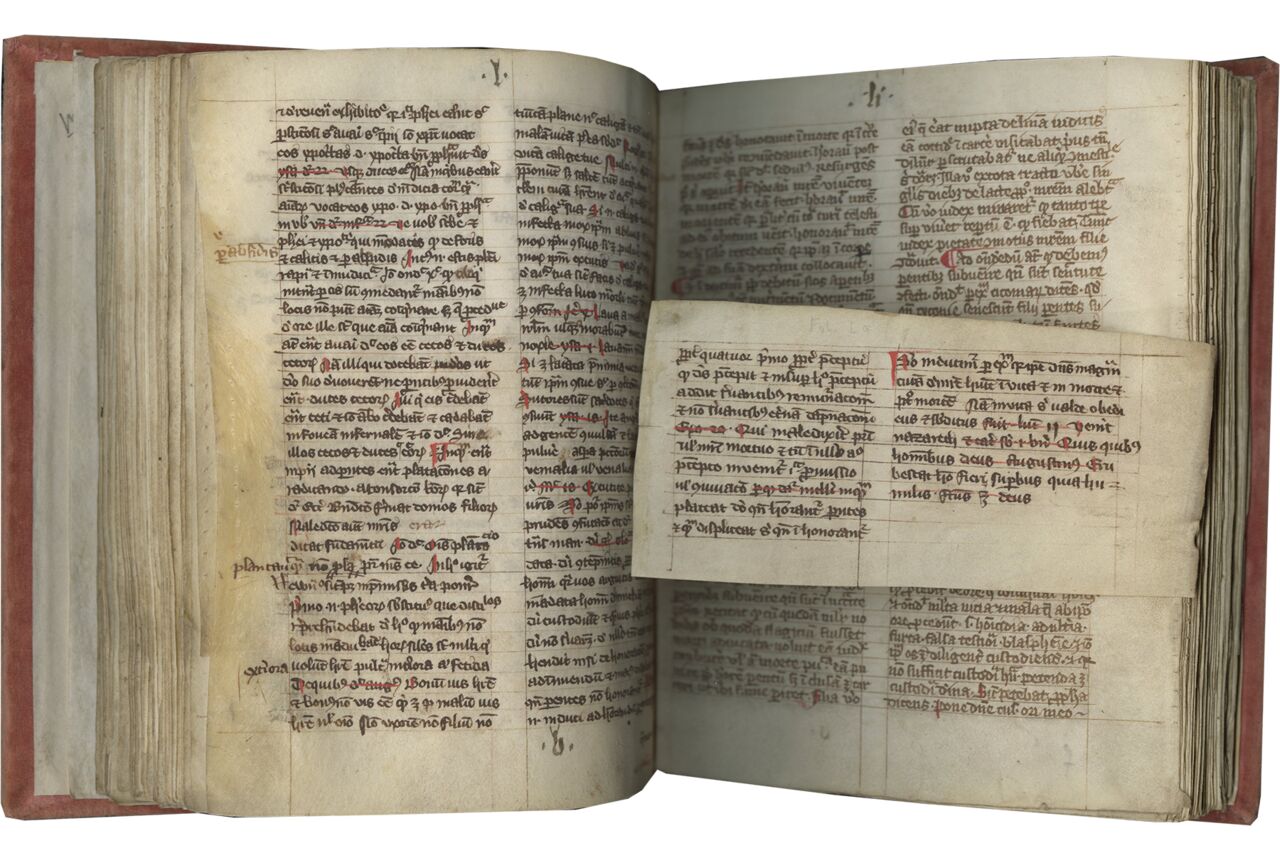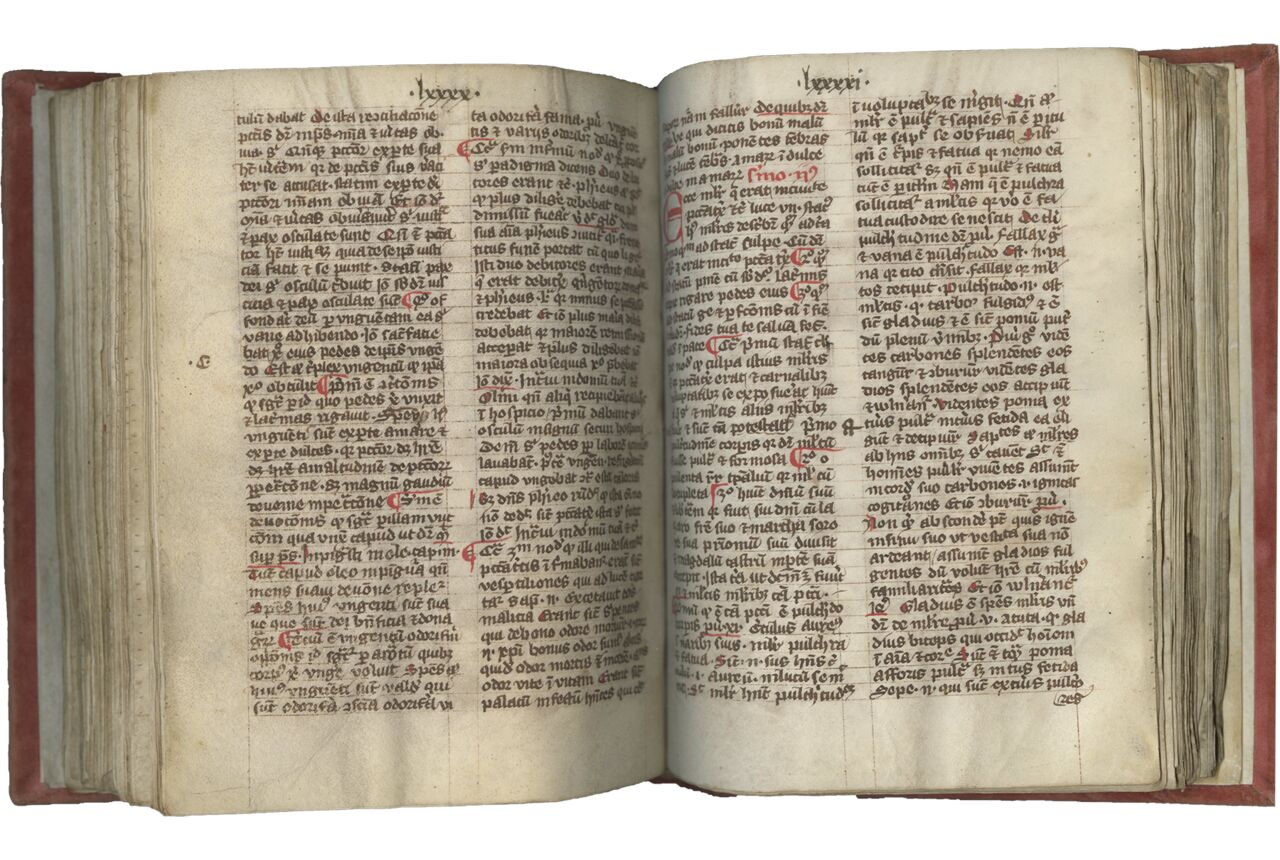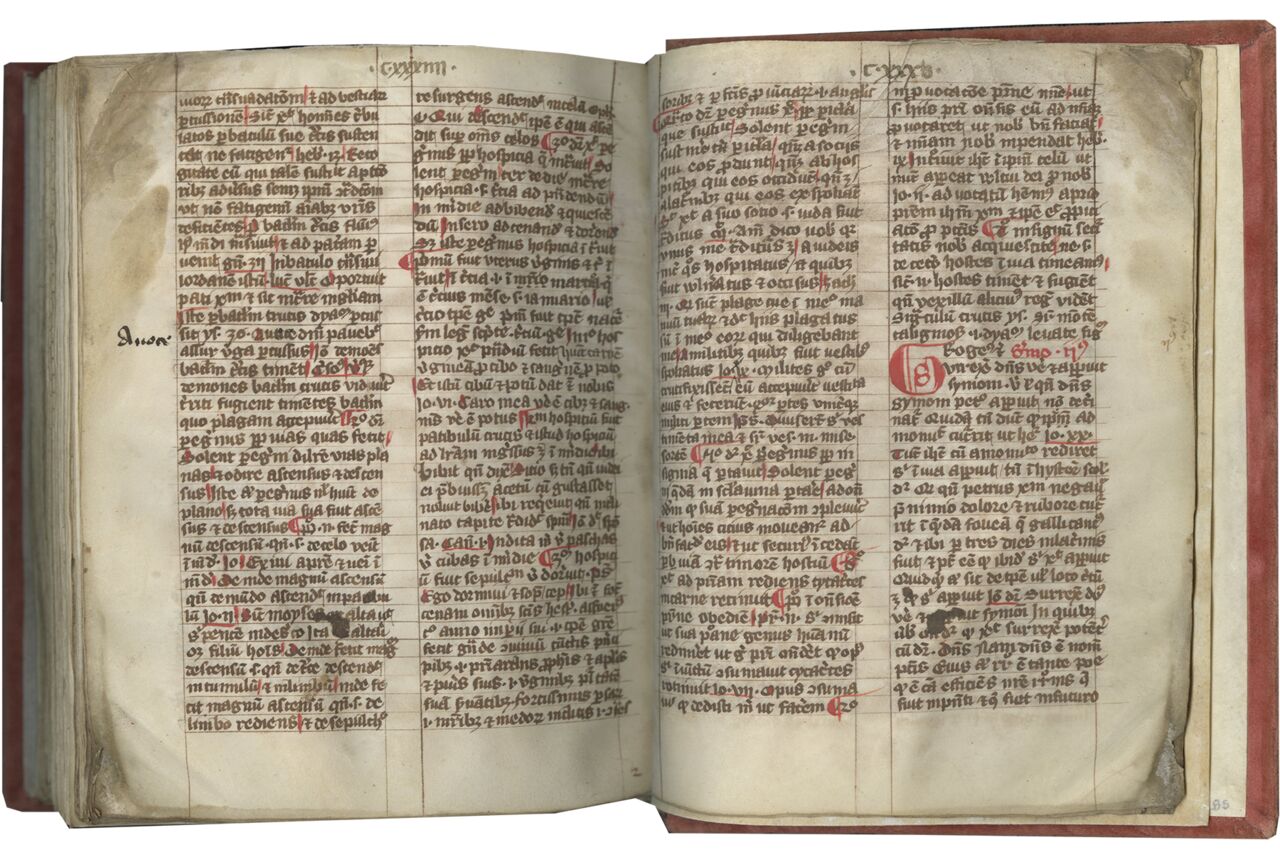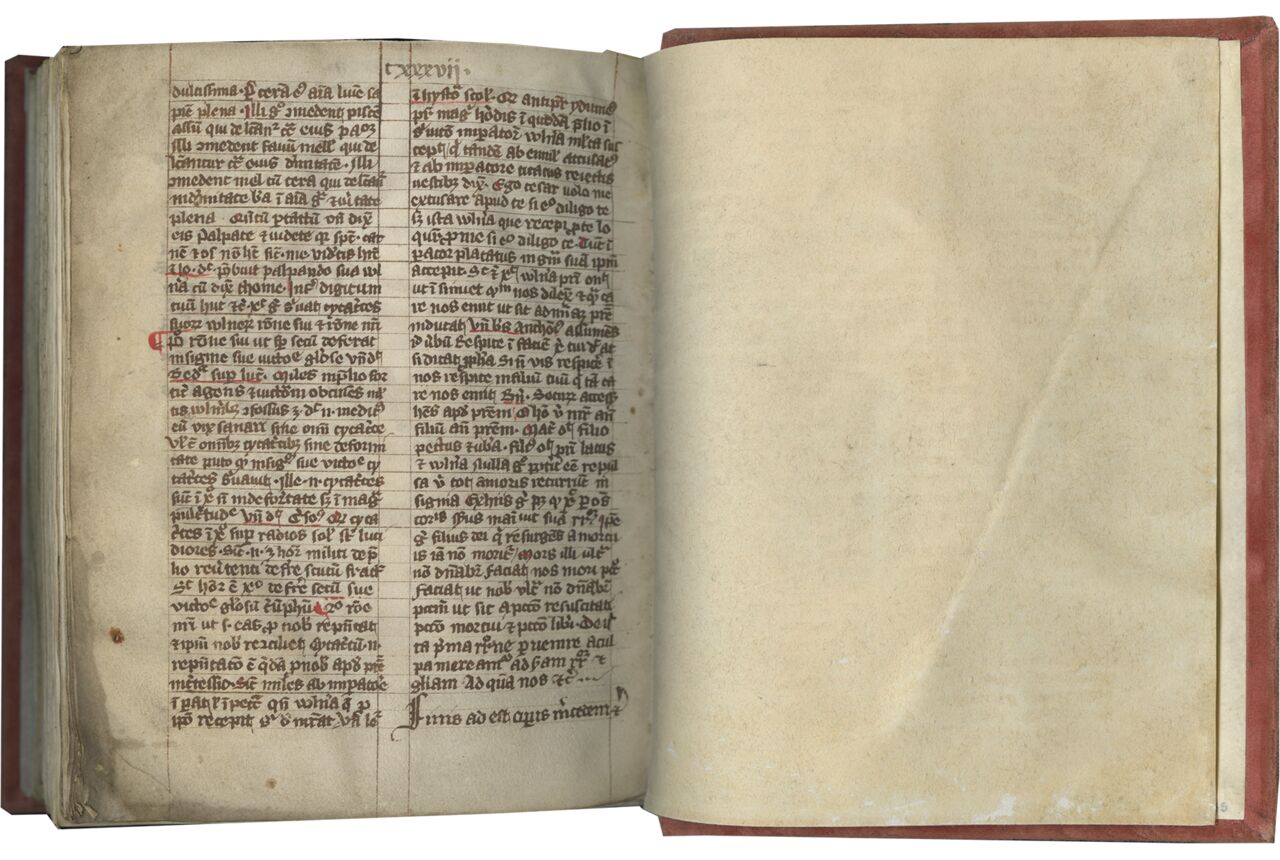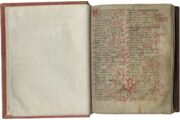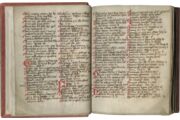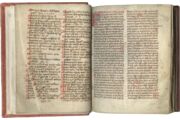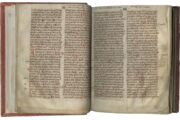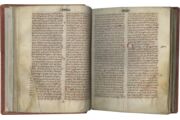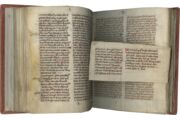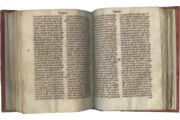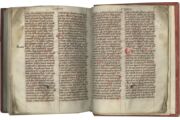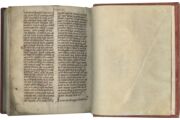i + 140 + i folios on parchment, medieval foliation in Gothic textura Roman numerals in black ink, top center, i-cxxxvij (ff. 6-140v) with numerals xcvix, cvii, and cxxxii-cxxxiii missing, and f. 156 unnumbered (apparently errors in numbering, since there are no gaps in the relevant quires), modern foliation in Arabic numerals in pencil [cited in this description], upper fore-edge recto, quires numbered in modern Arabic numerals in pencil, lower fore-edge recto, with two errors, 3 on f. 17 instead of f. 16, 4 on f. 29 instead of f. 30, missing at least one leaf (between f. 5 and f. 6), f. 56 is an inserted slip of parchment continuing the text from f. 55v (collation i6 [-6, following f. 5] ii10 iii14 iv10 v8 vi8 [+1, f. 56, after 8] vii-ix12 x-xi10 xii-xiii12 xiv4), occasional signatures at lower fore-edge recto in brown ink (e.g., f. 21), horizontal catchwords at ff. 47v, 55v, 112v, and the stub between f. 39 and f. 40, ruled in brown ink throughout (justification c.160-163 × c.115-127 mm.), pricking visible at most fore-edges and in upper and lower margins, written below top line in at least five Gothica textualis hands, with changes of hand at ff. 6, 40, 48, and 57, in brown or black ink, in two columns of 36 lines, except 28 lines at ff. 40-46v and 47v, 29 lines at f. 47, 34 lines at ff. 48 and 55v, 30 lines at ff. 48v-55 (f. 56 a slip of 10 lines), rubrics, paraphs, and underlining in red throughout, majuscules heightened in red, one 3-line penwork initial in red flourished blue and red at f. 6, plus 86 two-line and 17 three-line red initials, guide letter in brown ink at f. 62v, scribal corrections via erasure (e.g., f. 27, line 20), strike-through (e.g., f. 40v, line 27), and subpunct (e.g., f. 61v, line 5), further corrections and annotations in other hands throughout (e.g., ff. 17, 24v), sewn medieval repairs to parchment (e.g., ff. 25-26) with some irregularities remaining such as natural edge gaps (e.g., ff. 5, 30, 33, 54, 110), faded ink at f. 1, small tear and soiling at f. 136 with minor loss of text, occasional wrinkling and cockling, overall in very good condition. Bound, likely in the late 19th or early 20th century, in rose pink velvet over pasteboards, some fading, but in good condition. Dimensions c. 200 × c.150 mm.
One of the primary methods of educating ordinary lay people about theology and the faith; sermons can offer modern scholars a glimpse into daily life in the Middle Ages. Jacobus de Voragine, author of the Golden Legend, was one of the most influential authors of the thirteenth century, famous in his own lifetime and still well-known today. This is an early manuscript of his Lenten Sermons, which were composed before 1286, and as such, its text deserves further study. It is also a valuable witness to the reception of these popular sermons; the extensive signs of reader engagement throughout, including a detailed alphabetical subject index, keyed to the added foliation and marginal letters, are of special interest.
Provenance
1. Copied in Northeastern France, perhaps Alsace, or in the neighboring area in Germany, c.1300-1325, based on paleographical evidence. It concludes on f. 140v with a brief scribal colophon (without a date or identification of the scribe): “Finis adest operis mercedem etc.” (i.e., The end of the work has been reached; I ask for a reward for my labor [mercedem posco laboris]).
2. Index (ff. 1-5v) and medieval foliation (ff. 6-140v) added early-to-mid 14th century, a few decades after copying of sermons.
3. Unidentified armorial bookplate, inside front cover, “EX LIBRIS M. LUGOL,” Party per chevron Azure and Gules, a Chevron Or between two Estoiles Argent, in chief a Cock Argent, in base an Anchor Argent, possibly of Victor-Eugène-Marcel Lugol (1899-1976), Comptroller General of the Navy (Online Resources), although the writer and translator Julien Lugol (1837-1894) has also been suggested (on this Lugol, see Etienvre, 1976).
4. Modern (20th- or 21st-century) bookseller or owner annotations in pencil, by two hands: “<Mooost> 3295” and “<so7ec>” (inside front cover).
5. Brief modern description in German, front flyleaf, f. i, in pencil, “Jacobus de Voragine, kleine folio <?> (sermones quadragesimales etc) (süd?) Frankreich, ca, 1260-80 (Index ca. 1300-1320) V, 137 Blattes (fehlt 1 Bl. des Index?), sonst offenbar Komplett.”
6. Private Collection.
Text
ff. 1-5v, incipit, “Accepte sunt deo iiiior virtutes plus ceteris. xxiiij. c.; Accusatores tres erunt … xii .B. … Temptat dyabolus hominem multiplicatur .x.//”;
Subject index to the sermons, entries arranged alphabetically with references to folio numbers and corresponding letters added in the margins; now ending imperfectly with five entries for “T,” and lacking with the quire’s final leaf.
ff. 6-108, 111v-121, 124v-126, 132v-138, 139v-140v, In capite ieiunij id est in die cinerum, incipit, “Filia populi mei induere cilicio et conspergere cinere luctum unigeniti fac tibi planctum amarum. Je. 6 [Jeremiah 6:26], Quamuis sollempnitas [sic] quadragesimalis in sequenti dominica inchoatur [corr. inchoetur] … Miserere mei dominus quoniam conculcauit [sic] /me\ homo; …; … [final sermon], feria .iij, incipit, “Stetit ihesus in medio discipulorum suorum et dixit eis pax vobis ego sum nolite timere. Luc. .vlc. [sic; Luke 24:36], … Cum esset sero die illa una sabbatorum venit ihesus … de ista prima resurrectione peruenire a culpa mereamur ad secundam resurrectionem et gloriam. Ad quam nos etc.,”; [scribal colophon], Finis adest operis mercedem etc.
Jacobus de Voragine, Sermones quadragesimales, from Ash Wednesday to the second feria after Easter. This is the complete cycle of sermons, with small differences from Schneyer’s list (Schneyer, v. 3, 1971, pp. 238-246, lacking sermons 284 and 289, and with additional sermons, described below, by Jacobus de Voragine and Servasanctus de Faventia; see also Kaepelli, pp. 364-367, no. 2157 ); edited Maggioni, 2005; first printed with Sermones de sanctis: Lyons, Johannes Treschel, [c.1491], ISTC ij00198000, then alone: Brescia, Angelus and Jacobus Britannicus, 1483 [i.e., 1493?], ISTC ij00186000).
ff. 126-132v, [first sermon], incipit, “Auferam [sic] paxillum aque et lauentur pedes vestri [Genesis 18:4-5], Ista verba quae dixit abraham angelis possunt esse verba … ascendet fumus incensorum orationibus sanctorum de manu angeli coram deo; … [final sermon], In sabbato sancto, “Caro mea requiescet in spe psalmus [Psalm 15:9], Christus qui olim requievit in sabbato … Ascendit sumus in censorum de orationibus sanctorum de manu angeli coram deo.”
Copied as an integral part of this sermon cycle in this manuscript are six sermons from Jacobus de Voragine, Sermones de sanctis et festis, Maundy Thursday to Holy Saturday (Schneyer, v. 3, 1971, pp. 246-267, nos. 399, 404-405, 407, and 411-412); printed in multiple incunable editions, including by Conrad Winters de Homborch at Cologne in 1478 (ISTC ij00187000), and by Hermann Kästlin at Augsburg in 1484 (ISTC ij00188000); edited, Clutius, 1760, with an electronic edition planned by Sermones.net.
ff. 108-109v, 109v-111v, 121-122v, 123-124v, Item de eodem feria .ij primus, incipit, “Hoc enim sentite in vobis quod et in Christo Iesu, phl. ij. [Philippans 2:5]. Ut amorem divinum cum incitemur … per haec quae doluerunt [sic] id est male amaverunt dedisti dura tormenta”; [Second sermon], de eodem, “Sanguis eius super nos et super filios nostros [Matthew 27:25], Hodierna die sollemnitas habet gaudii … et super filios nostros quam utilitatem ipse nobis concedat qui cum patre et cetera”; [third sermon], “Domine tu mihi lavas pedes. Io. [John 13:6], Si quis a sensualitate astatus [sic] altitudinem mentis abscondat … et propheta dicebat lavabo per singulas noctes lectum meus stratum meum rigabo Ista concedat”; [fourth sermon], “Tradidit in mortem anima suam. ysa. 53 [Isaiah 53:12], Sicut ex verbis salvatoris habetur … et cum laude continua”;
Four sermons from Servasanctus de Faenza, Sermones de tempore et de sanctis; Schneyer, v. 5, 1973, pp. 379-380, nos. 55, 56, 59, and 61, also copied as part of the Lenten Sermons; see also Pseudo-Bonaventura, Online Resources; printed in multiple incunable editions, including Johannes de Vollenhoe at Zwolle in 1479 (ISTC ib00948100), and Johann Otmar at Reutlingen in 1485 (ISTC ib00951000), as well as a number of Early Modern and modern editions, all spuriously attributed to Bonaventura (Distelbrink, 1975, pp. 184-185, 187; Schneyer, 1973, p. 392).
ff. 138-139v, Sermo secundus, incipit, “Surrexit dominus vere et apparuit symoni. Ubi vel quando dominus symoni petros apparuit non determinator [cf. Luke 24:34]. Quidam tamen dicunt que ipsem ad monumentum cucurrit ut habetur. Io. .xx. … eum benigne consolatus fuit.”
Jacobus de Voragine, Sermones de tempore, sermon for the Octave of Easter (feria secunda post pascha); Schneyer, v. 3, 1971, p. 244, no. 290 (also incorporated within the Lenten Sermons).
Jacobus de Voragine (born c.1230 in Varazze, near Genoa; died c.1298) entered the Dominican order in 1244, travelled as a preacher in many parts of Italy, and taught in the Order’s schools. He also led a distinguished career in ecclesiastical service, first as provincial of Lombardy, then as a delegate from his province at the councils of Lucca (1288) and Ferrara (1290), and finally as bishop of Genoa (1292-1298). He is most famous today for his collection of saints’ lives, the Legenda aurea (The Golden Legend), and he was also the author of three very popular and influential collections of model sermons: Sermones de sanctis et festis, written after Legenda aurea and mentioned in its preface (likely c.1260, though Fleith argues it was begun as early as 1252), Sermones de tempore, and finally Sermones quadragesimales (or Sermons for Lent), written before 1286 (date of one extant witness, and perhaps after 1277, when Jacobus had completed his term prior of the province of Lombardy; see Carloa Casagrande, Online Resources). Extraordinarily popular even beyond the Dominicans, this troika of sermon cycles were embraced as standard sources by preachers across Europe. They were without a doubt medieval bestsellers. The 98 Lenten sermons survive in more than 300 manuscripts (Maggione, 2005, appendix; Kaeppeli, 1975, pp. 364-367, no. 2157; Schneyer, vol. 3, 1971, pp. 238-246; Fama, Online Resources); this is the only cycle that has been edited in a modern edition (Maggione, 2005; see Sermones.net for discussion, a digital edition of Sermones quadragesimales, and plans for further digital editions).
In this manuscript, Voragine’s Lenten Sermons are augmented with half a dozen of his Sermones de sanctis et festis, as well as one of his Sermones de tempore, and interspersed with five additional sermons by the thirteenth-century Franciscan friar Servasanctus de Faventia (Servasanto da Faenza, d. c. 1300). Little is known about Servasanctus – even his name, possibly Jacobus Servasanto or Servasanto of Giacomo/Oriolo, remains uncertain – but early editions widely misattribute his sermons to Bonaventura (Dansereau, 2015, pp. 28-33; Distelbrink, 1975), as seen in their earliest imprint (Zwolle, [Johannes de Vollenhoe], 1479, ISTC ib00948100) and the 1485 Reutlingen imprint (ISTC ib00951000, where the sermons found in our manuscript begin at ff. 73v, 75, 80, and 83v).
This collection opens with a list of subjects found in the included sermons. Entries in this index are arranged alphabetically, with each cross-referenced not only to a folio numeral, but also to a letter marked in the margin adjacent to the corresponding passage. Both the carefully structured register, and copious marginalia and corrections in a variety of 14th-century hands, reveal that our manuscript was used extensively for a long period of time.
Giovanni Paolo Maggioni based his edition of Voragine’s Sermones on five 13th-century witnesses from the text’s most important regions of circulation, Italy and Germany (with consultation of a later manuscript for the insular tradition), and is intended as a preliminary step towards a definitive edition. The question of whether our manuscript represents a distinct early tradition of Voragine’s Lenten sermons awaits further paleographic and philological analysis. Beyond its potential textual importance, this is a practical manuscript made for reference that offers important new evidence for the reception history of this cycle of medieval sermons by one of the most influential authors of the thirteenth century. Frequent annotations and corrections by multiple hands, in tandem with the detailed alphabetical index – which, like the added foliation, post-dates the sermons’ copying by several decades – reveal extended consultation by multiple users over at least several decades.
Literature
Distelbrink, Balduinus. Bonaventurae scripta: Authentica dubia vel spuria critice recensita, Subsidia Scientifica Franciscalia 5, Rome, 1975.
Etienvre, Françoise. “Galdós en France avant Electra. Notes sur les articles critiques et les traductions. Lettres inédites de Galdós, Heredia et Zola,” Bulletin Hispanique, 78, n°1-2 (1976), pp. 99-136, at p. 115.
Fleith, Barbara. Studien zur Überlieferungsgeschichte der Lateinischen Legenda Aurea, Subsidia hagiographica 72, Brussels, 1991.
Fleith, Barbara and Franco Morenzoni, eds. De la sainteté a l’hagiographie: Genèse et usage de la Légende Dorée, Geneva, 2001.
Kaeppeli, Thomas. Scriptores Ordinis Prædicatorum Medii Ævi, Rome, Ad S. Sabinæ, 1975, vol. 2, pp. 348-369.
Kienzle, Beverly, ed. The Sermon, Typologie des sources du moyen âge occidental 81-83, Turnhout, 2000.
Schneyer, Johann Baptist. Repertorium der Lateinischen Sermones des Mittelalters: für die Zeit von 1150–1350, Heft 2 (Autoren: E–H), Beiträge zur Geschichte der Philosophie und Theologie des Mittelalters 43, Münster, 1970.
Schneyer, Johann Baptist. Repertorium der Lateinischen Sermones des Mittelalters: für die Zeit von 1150–1350, Heft 3 (Autoren: I-J), Beiträge zur Geschichte der Philosophie und Theologie des Mittelalters 43, Münster, 1971.
Schneyer, Johann Baptist. Repertorium der Lateinischen Sermones des Mittelalters: für die Zeit von 1150–1350, Heft 5 (Autoren: R–Schluß [W]), Beiträge zur Geschichte der Philosophie und Theologie des Mittelalters 43, Münster, 1973.
Thayer, Anne T. “Ramifications of Late Medieval Preaching: Varied Receptivity to the Protestant Reformation,” in Preachers and People in the Reformations and Early Modern Period, ed. Larissa Taylor, Boston, 2001, pp. 359-386.
Varazze, Iacopo de. Sermones quadragesimales. Edizione critica, Edizione Nazionale dei Testi Mediolatini 13, ser. I, 8, ed. Giovanni Paolo Maggione, Florence, 2005.
Voragine, Jacobus de. Sermones aurei in omnes Quadragesimae Dominicas and Ferias, De praecipuis sanctorum festis et Laudibus deiparae virginis, ed. Rudolph Clutius, Augustae Vindelicorum-Cracoviae, 1760.
Wenzel, Siegfried. “Sermon Collections and their Taxonomy,” in The Whole Book: Cultural Perspectives on the Medieval Miscellany, ed. Stephen G. Nichols and Siegfried Wenzel, Ann Arbor, University of Michigan Press, 1996, pp. 7-22.
Online Resources
Académie française. “Julien Lugol,” Les prix et fondations
https://www.academie-francaise.fr/node/16555
Dansereau, Raymond Joseph. Servasanto da Faenza: Preaching and Penance in the Work of a Thirteenth-Century Franciscan, PhD diss., Rutgers, The State University of New Jersey, 2015
https://rucore.libraries.rutgers.edu/rutgers-lib/46322/PDF/1/play/
FAMA: Oeuvres latines médiévales à succès http://fama.irht.cnrs.fr/en/oeuvre/268566
ISTC: International Short-Title Catalogue
https://data.cerl.org/istc/_search/
“Jacques de Voragine,” Sermones.net: Édition électronique d’un corpus de sermons latins médiévaux
http://sermones.net/content/jacques-de-voragine
http://sermones.net/thesaurus/list.php?coll=voragine%2Fquadragesimale (edition of the Quadragesimale)
Carla Casagrande, “La vie et les oeuvres de Jacques de Voragine, o.p.“
http://sermones.net/content/la-vie-et-les-oeuvres-de-jacques-de-voragine-op
Pseudo-Bonaventura [Servasanctus de Faenza]. Sermones de tempore et de sanctis, Reutlingen, 1485, ISTC ib00951000. Digital surrogate: Darmstadt, Universitäts- und Landesbibliothek, Inc. IV 472
https://tudigit.ulb.tu-darmstadt.de/show/inc-iv-472/0469/
Roest, Bert and Maarten van der Heijden, “Franciscan Authors, 13th-18th Century: A Catalogue In Progress“ (Servasanctus de Faventia, Servasanto da Faenza, d. c. 1300)
http://users.bart.nl/~roestb/franciscan/
Voragine, Jacobus de. Sermones quadragesimales, Brescia, [1493], ISTC ij00186000. Digital surrogate: Subiaco, Biblioteca statale del Monumento nazionale di Santa Scolastica, XVII.A.17
http://digitale.bnc.roma.sbn.it/tecadigitale/libroantico/FOGE034801/FOGE034801/1
Voragine, Jacobus de. Sermones de sanctis, [Cologne, c.1478], ISTC ij00187000. Digital surrogate: Cologne, Universitäts- und Stadtbibliothek, GBIV220
https://www.ub.uni-koeln.de/cdm/compoundobject/collection/inkunabeln/id/47306/rec/1
TM 1285


